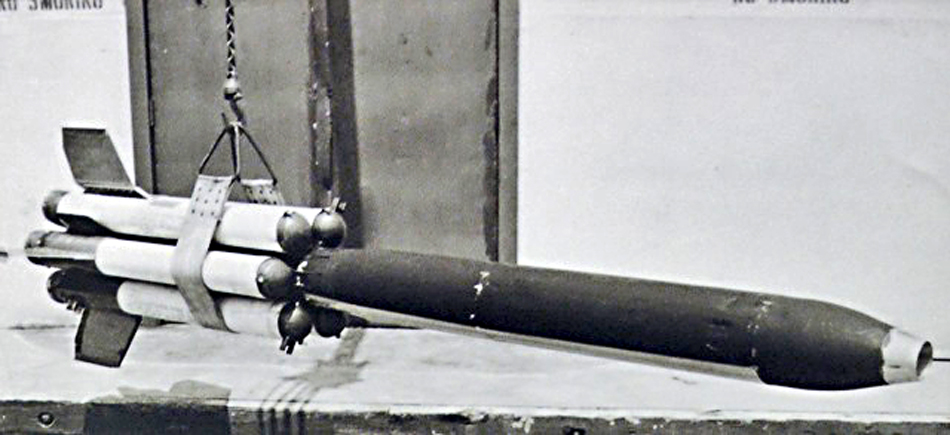
For the early "Cobra" ramjet test vehicle APL wanted us to make an inlet nose cone that was insulated from the rest of the missile. They wanted to use the nose cone as an antenna for the telemetry system. We knew of a plastics company in South Bend and asked them for advice.
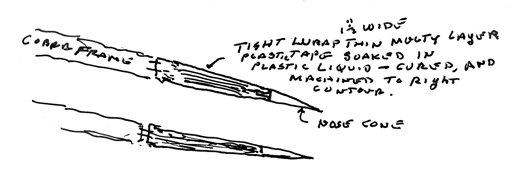
They suggested something like this. I hope you get the picture: It used a tight Lurap 1 ½" wide thin multi-layer plastic tape soaked in plastic liquid, cured, and machined to the right contour.
We asked the project manager how strong and durable that would be. He said "Come on and I'll show you." So we walked outside to his brand new Chrysler. The company was beginning to make plastic parts for the auto industry. He had a heavy hammer and he banged away on the front fender, much to our surprise. No damage done - it was a plastic fender made by his company. We were convinced, and a number of the Cobra noses were made that way. However, the first one fired was spectacular. A leading edge of the inner tapes of the cone came loose - and the entire structure unwound from the inside and exited the back of Cobra and left about a mile long string of tape in the air - and the nose cone fell off. No one was happy, but things like that happened and made life interesting.
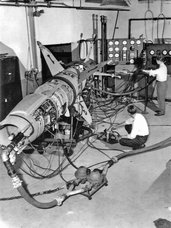
This photo is in our fuel system lab in the Mishawaka plant. Date-wise I'm not sure - probably late 1950s - maybe 1956. This could be the first entire missile we rolled into the lab to test most of the installed fuel control system in operation. That's me on far right. The big hose going into the missile inlet is the air hose to drive the air turbine fuel pump. We had a hard time finding an air regulator that would handle the air volume required to run the air driven turbine fuel pump. So we ganged together in parallel two of the biggest air pressure regulators we could find. So that is what you see on that little cart with casters. We named that contraption Dagmar after some Hollywood beauty at that time. You can understand why.
Another part of the story is that on one set-up of this kind the quick disconnect hose device on the inlet to Dagmar came loose under full pressure and the long hose with connector swung around wildly, luckily not hitting anyone, but hitting the "CARDOX" fire suppression switch and setting off the CO2 which flooded the lab to the extent you couldn't see. We all got out but one man, the lab manager. He wandered around in there trying to find the switch to shut off the CARDOX system. We all panicked thinking he had suffocated, but he finally stumbled out.

When we moved from South Bend to Mishawaka in March 1951 there was just one building on the property - an old abandoned furniture factory. As the Talos program advanced it became sure this location would be the production location. Many new buildings were constructed, one of which was the Quality Control Building. In this building was every kind of test equipment you can think of, including a very large centrifuge located in a sunken concrete pit about 8' deep and maybe 20' or so in diameter. All inputs required to operate our complete fuel system - air pressure, fuel, electric, etc. - were incorporated in the centrifuge design. We could put our fuel system on the centrifuge and operate it exactly like on the Talos installation. We tested our complete fuel system on this centrifuge to simulate launch and flight G's.
All inputs to our fuel system came from the center axle of the centrifuge through slip rings and quick disconnects. Around the top of the centrifuge pit were a row of high intensity lights to provide illumination. On our first full test, with our lab manager down in the pit in a recess for observation and the centrifuge at pretty high RPM, one of the quick disconnects on our fuel line hose or our air hose to the turbine fuel pump came loose at the centrifuge axis. This hose swung freely from our fuel system, and with the heavy disconnect fitting on the end it was just long enough to wipe out all the high intensity lights on the centrifuge pit wall. For an instant or so it was panic city. We didn't know if it was the fuel hose or the air hose and we expected a major fire and our man was in the pit. Fortunately it was the air hose - another case of a quick disconnect failure.
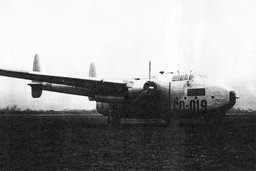
This is a photo of a "flying box car" cargo plane at South Bend Airport. This plane landed at South Bend and took the very first full sized Talos to either Inyokern or maybe to APL (I'm not sure). It was the very first full size Talos. This photo was taken before we moved from the South Bend plant to Mishawaka, so I would say probably in 1950. Anyway no more Talos were flown by an airplane - all subsequent went by truck/trailer and eventually steel shipping containers especially designed for shipping Talos by a truck and maybe train.
Why was the first Talos built at the South Bend plant while all others came from the Mishawaka Missile Division following March 1951? The first Talos airframe and combustion section probably came from McDonnell in St. Louis. At Bendix South Bend we had, besides the mechanical area, a real good start on the guidance, telemetry, and electrical areas (radio tube era then) This first airframe was pretty much put together at Bendix South Bend by our Talos group.
One of the major tasks was to do a vibration or shake test on the entire assembled Talos with all the electronics operating. In our effort to come up with a shake table large enough we heard about a mechanical device with rotating weights that was used to test bridge structures. Cornell University seemed to know something about this, and we had them build us a large table incorporating a number of these mechanical shaking units - all ganged together and controlled from a single hand wheel. They up shot is we stood the assembled Talos on its tail on the table, turned electronics on and shook, breaking about everything including the shake table. After fixing things, this first Talos was shipped by the flying boxcar in the photo.
The other part of the story is that the Bendix shipping department was not accustomed to "classified" material and they went full bore "secret." This Talos was shipped from the Bendix plant to the airport on a flatbed trailer truck disguised with tarps and other devices that there would be no way for someone to guess that this was a missile.
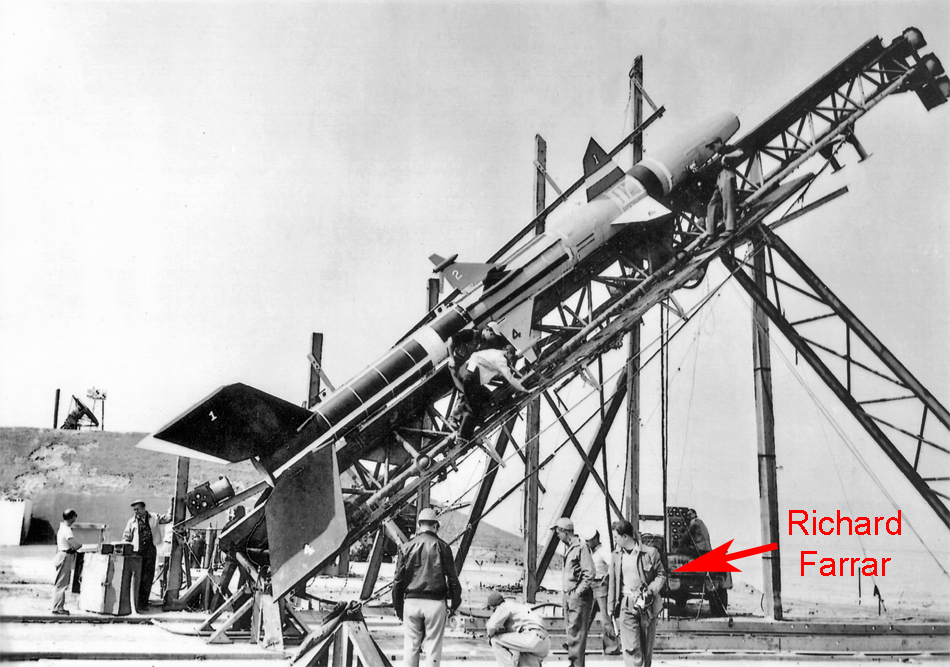
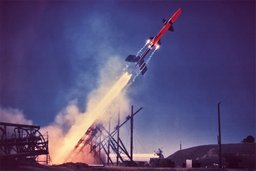
The photo with the Talos missile on the launcher I believe was taken at Inyokern and was the last Talos fired from there, in March 1951. I'm the guy on the far right, walking away. Jack Holloway was the guy in the center in the leather jacket with his back to the camera.
Seeing the missile elevated this way reminds me of another story. The missile was full of fuel and there were no positive seals from the fuel tank, through the fuel system and on to the pilot and main fuel injectors in the combustor. So there was a constant drip, drip. With a slight breeze, fuel vapors surrounded the missile. The fellows working on the launcher for last minute checks, and those on the ground around the launcher, complained a lot. This led our group to design a positive shut-off valve to be located right at the fuel tank outlet. We wanted a simple device, self-activated with no electrical connections or any complicated gadgetry. We came up with a G activated weight that released a spring loaded seal. It took some time for us to convince everybody that this could not fail. Launch G's would get that valve open for sure.
We spent a lot of time at White Sands, New Mexico, on Talos development firings. Bendix had a good size field office at White Sands during the Talos developments and probably did also after the 1970 work on ground target homing and targets for other advanced programs beyond 1970.
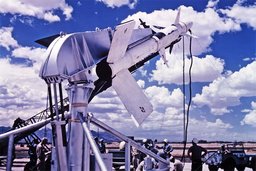
On each launching several people from my group in Mishawaka would be at White Sands to check out our equipment before launch. In afterhours it was the thing to do to go down to El Paso and over to Juarez (Mexico). Two men from my group were at White Sands for a Talos launch (early sixties era), and as was the custom went over to Juarez one night. They were in a nightclub and a big fight broke out. In trying to get out of there they ran out into the street with a lot of other people (mostly Mexicans) and the Juarez police spotted them and put them in jail. The next morning they did not show up at the base; and somehow we found out that our two Bendix guys were in jail in Mexico. We joked among ourselves, "we will never see them again." How they got out and what it cost I do not know. But our Bendix office manager at White Sands and most likely some White Sands proving ground official took care of it. I expect it is a much tougher situation today.
